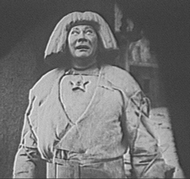The Stone Man Lives

The concept of artificial life has existed for hundreds of years, such as the myth of Pygmalion and Galeta. The most famous story is Mary Shelly's Frankenstein. But before that there was the tale of the Golem; a man of clay brought to life.
The Jews of the Prague ghetto were to be forced out on orders of the emperor. Rabbi Loew, using mystic arts, created the Golem as the protector of the Jews. But the Golem soon rebelled and threatened everyone.
German director Paul Wegener filmed the story three times, in 1915, 1917 and 1920. Only the third film, The Golem and How He Came Into the World, remains and it is well worth seeing. Kino offers a restored print that is quite lovely. Rabbi Low (Albert Steinruck). aided by his servant (Ernst Deutsch), in an impressive scene, summon a demon who gives them the word needed to bring the inanimate statue to life. The Golem saves the Emperor from death and the greatful ruler rescinds his order of expulsion. But the Golem enjoys life and refuses to allow anyone to remove the amulet containing a piece of paper with the sacred word.
The Golem goes on a rampage, killing a German knight who has fallen in love with the Rabbi's daughter and then goes on a rampage, destroying the Rabbi's house and threatening the rest of the ghetto. The Golem breaks out of the ghetto where he finds children playing with flowers. All run, except for one small girl who offer the Golem a flower. The creature picks up the girl who innocently removes the amulet, and the Golem falls lifeless.
The 1931 Frankenstein certainly resembles this film from 16 years earlier. One of the Cinematographers on this production was Karl Freund, noted for The Mummy and other Universal films of the 1930s. Edgar G. Ulmer, who gained a cult following for his unusual low budget features in America was the set designer. Some reports stated that the first makeup design for the Frankenstein monster resembled the Golem.
The Golem certainly fits in with the post World War I expressionistic films in Germany, such as The Cabinet of Doctor Caligari and Nosferatu. The set designs are certainly unreal, but they fit the world of the story. Performances are good for the most part, especially the director Wegener who also portrays the Golem. His wife, Lyda Salmonova, portrays the Rabbi's daughter. The portrayal of the Jews is very sympathetic and avoids the usual anti-Semetic stereotypes of the time.

The Kino DVD features a careful restoration, properly tinted and featuring an original score. The story certainly benefits from the treatment and this is one film that definitely deserves to be called a classic. Extras include a clip from the 1936 French production of the story, photo gallery, and a scene from Murnau's Faust production that compares with the scene in which the demon is summoned by the Rabbi.
Recommended without reservations.



Comments